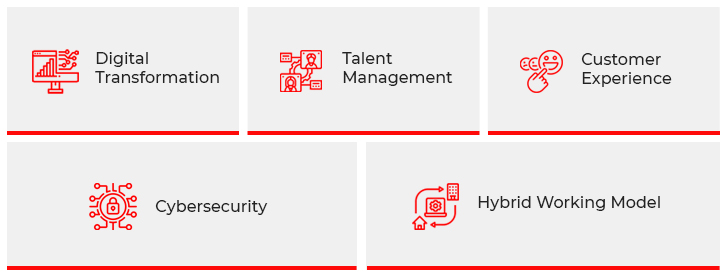The role of captive centers, also known as global capability centers, has slowly but steadily evolved from performing traditional back-office tasks to driving strategic technology initiatives for their parent organizations. With an aim to become an innovation hub, these centers are continually diversifying their talent pool and investing in digital technologies to transform their operating models.
To deliver on these objectives, there are five key areas captive centers need to pay attention to-digital transformation, talent management, customer experience, hybrid working model, and cybersecurity. In this article, we will delve into these focus areas and how companies can leverage them to enable the imperatives of growth and innovation.

1. Digital Transformation
During the pandemic, we witnessed a significant digital transformation as captive centers migrated their legacy applications to the cloud and embraced advanced technologies such as artificial intelligence, machine learning, and advanced analytics across various business functions.
This rise in technology investment will continue in the years to come, thanks to the increased demand for advanced tech tools and data mining and processing capabilities. Delivery centers must emphasize innovation in order to stay competitive in a rapidly-evolving landscape and become tech hubs for their parent organizations.
Case in Focus
A Princeton-based multinational company was manually processing all their invoices, making the process cumbersome and error-prone. To overcome the challenge, the client sought Damco’s captive center expertise to design and implement an AI-powered invoice processing solution.
The solution successfully handled end-to-end invoice processing, resulting in a remarkable reduction of invoice processing time from 2-3 hours to just 5 minutes. This significant improvement allowed the client to focus on strategic tasks and increased their overall productivity. Additionally, the solution ensured high levels of processing accuracy and compliance with regulatory requirements.
Slash Development Costs With Our Global Capability Centers
2. Talent Management
The inability to attract and retain talent with niche skills has become a significant concern for delivery centers. The ongoing tussle for talent has led to higher people costs due to the increased demand and salary expectations for individuals with niche skills and tech expertise.
To address this challenge, organizations must take a proactive approach to attract, develop, and retain top talent. This necessitates a greater focus and investment in hiring and reskilling the workforce with niche skills such as AI/ML, data analytics, and blockchain among others. Lateral hiring can also help augment the talent pool for niche skills, but more than anything else, it’s imperative for captive centers to provide a conducive environment that fosters continuous learning, upskilling, and rewards high performers.
3. Customer Experience
While customer experience has always been important for captive centers, it will become a key differentiator in 2024 and beyond. With customers becoming more demanding and discerning, businesses will need to focus on delivering exceptional experiences that meet or exceed their expectations.
This entails investing in customer service technologies, training employees on customer service best practices, and building a culture that prioritizes customer satisfaction. Captive centers that can forge strong relationships with the customer will be better positioned to capture new business opportunities.
4. Cybersecurity
Cybersecurity is a growing concern for organizations of all sizes. Cyber attacks are becoming more sophisticated and frequent, and the consequences of a successful attack can be devastating. As per a recent study by Cybersecurity Ventures, cybercrime is expected to cost businesses $10.5 trillion annually by 2025.
In light of these circumstances, captive centers need to prioritize cybersecurity to safeguard their operations and their client’s data. This can be achieved by implementing robust security protocols, investing in advanced security technologies, and training employees on how to timely identify and respond to potential threats.
5. Hybrid Working Model
Hybrid working models are an emerging trend in captive centers, as companies continue to navigate the changing landscape of work post-pandemic. The model enables organizations to tap into a global talent pool, leveraging the advantages of both on-site and remote working. A hybrid workplace also reduces the need for large physical office spaces and allows for cost savings on infrastructure and facilities.
Having said that, to implement a hybrid model, organizations will need to build a robust technology infrastructure capable of supporting seamless collaboration, communication, and data security. Captive centers that embrace hybrid work today are likely to reap the benefits of increased employee satisfaction, retention, and productivity in the long run.
The Final Word
In this day and age, captive centers have the opportunity to evolve into an innovation engine driving the transformation agenda of their parent organizations. To achieve this transition, these centers will need to invest heavily in the aforementioned focus areas and align their goals and priorities with their parent organization. To learn how you can leverage the advantage of Damco’s global capability centers, connect with our tech experts.





